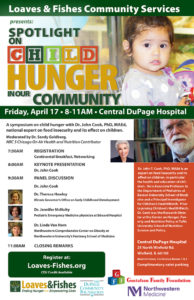School systems may have many challenges in their attempt to provide a new level of healthy foods to students. That doesn’t surprise me really. It’s only been five years since Michelle Obama began to promote the Let’s Move initiatives, and despite the flack from the school yards, I am glad to see someone finally put a stake in the sand. I am happy to say that the wave she started has even washed over the shores of emergency food providers like Loaves & Fishes.

I asked Toni Havala, MS RD LDN who is currently serving on the Loaves & Fishes Nutrition Advisory Council, about her thoughts on the healthy eating standards that have finally made their way to our schools. “I feel that the reductions in sodium, fat, and calories in school lunches are good ones. Taste preferences have been shown to be established between the ages of 1-5 years old, so it’s especially important for toddlers and preschoolers to eat healthier. However, children who have eaten a diet high in sodium, sugar, and fat (which is the majority of American kids) aren’t initially going to enjoy healthier options because they aren’t used to it. This may result in more food waste at school.”

It is my hope that we can work more closely with our community schools to continue to change the thinking about healthy foods. Low-income families often struggle with the attitude that it takes too much money to eat in a healthy way. But there are many cost effective solutions that support health. It might take a little time, maybe even trial and error, but with perseverance and education we can get past the barriers.
Community Impact models like IAPO (the Illinois Alliance to Prevent Obesity) can be highly effective mechanisms for sustainable change. Collaborative initiatives throughout the DuPage community undertaken by the FORWARD coalition (Fighting Obesity Reaching Healthy Weight Among Residents of DuPage) are already making great progress on childhood obesity in our area.

When I was growing up, I thought that a pop tart was a wonderful way to start the day. Check it out. I haven’t had a pop tart in years.
Jane Macdonald
Director of Nutrition & Wellness
Learn more about current food waste in schools by clicking here.
Learn more about Michelle Obama’s Let’s Move initiative by clicking here.